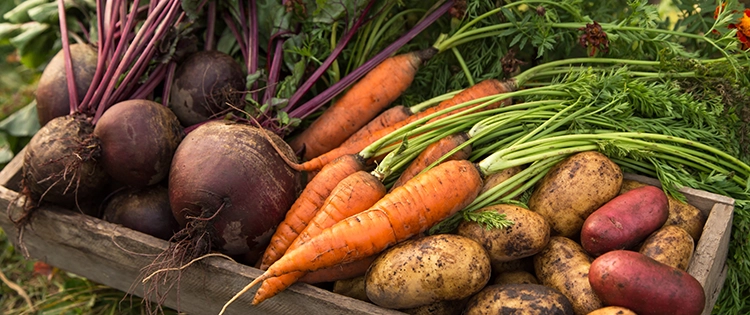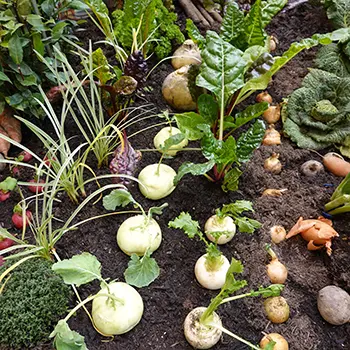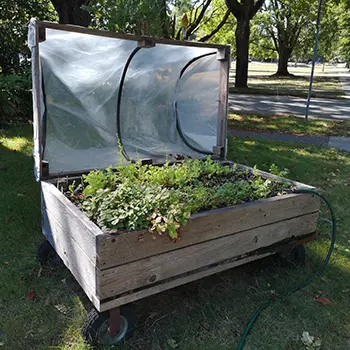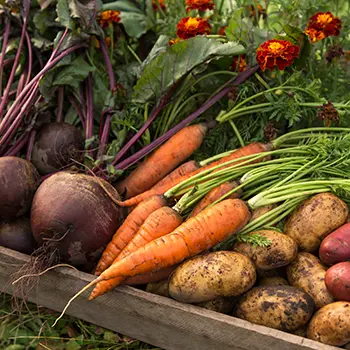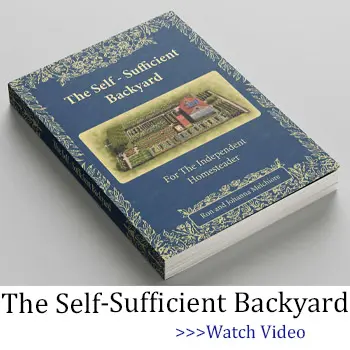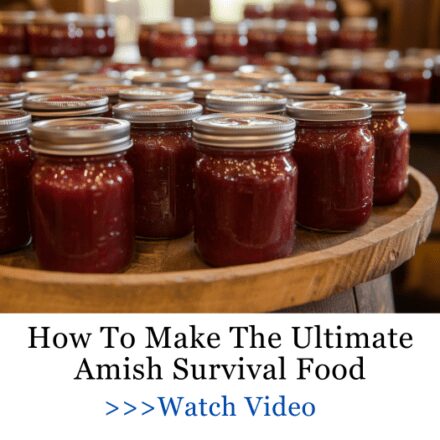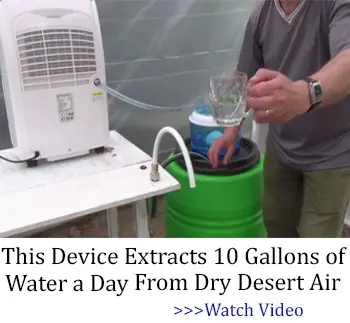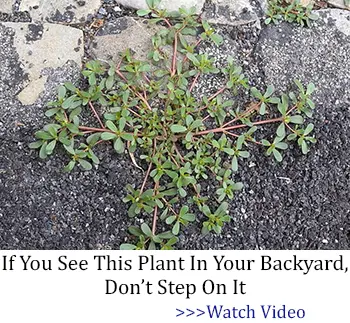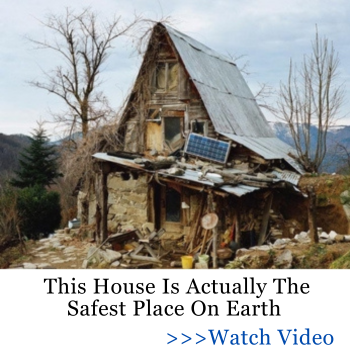As I stood in the grocery aisle, staring at the $4 price tag on a measly bunch of kale, I knew something had to change. The cost of living crisis had hit hard, and my weekly grocery bill was skyrocketing.
Living in a modest home in rural Missouri, I decided to take matters into my own hands and turn my tiny 10×10-foot front yard into a productive garden.
My goal?
To see if I could actually save money growing my own food. Spoiler alert – I did! And if a lazy homesteader like me could make this work in a tiny yard, you could too, so follow along.
The Setup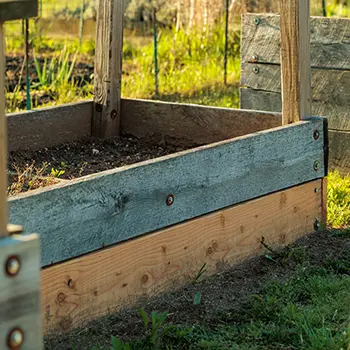
My yard was basically a rock garden. Instead of digging into the ground, I had to pivot to raised beds. I scrounged some anti-weed fabric from a construction site dumpster (with permission, of course) and laid it down for pathways.
Then I bit the bullet and bought some wood – my biggest expense of the project.
I’m no carpenter, but I managed to cobble together five raised beds. You should’ve seen me out there, measuring twice and cutting once, trying to make sure everything fit just right. I filled them mostly with organic material I got for free from local farms, topped with a thin layer of purchased soil. To keep costs down, I split a bulk bag with my neighbor.
Seeds and Starts
While the beds were settling, I started seeds indoors. Lettuce, herbs, and other quick-growing greens sprouted on my windowsills.
As spring rolled around, I planted my seedlings and added a few established plants to give myself a head start. I factored those costs into my final tally, don’t worry. I’m all about transparency here. One of my best early investments was a $30 compost bin. It wasn’t fancy, but it got the job done. By mid-summer, I had “black gold” to feed my plants.
The Growing Season
As the weather warmed, my little garden exploded. I was out there every day, watching in awe as things grew.
The first harvest was a game-changer. Instead of running to the store, I’d step outside and snip what I needed for dinner. It felt like I was cheating the system somehow.
I started a spreadsheet (yes, I’m that guy) to track every harvest. I’d weigh my haul and price it against what I’d pay at our local budget grocery store. It became addictive, watching those savings add up.
We started eating differently, too. More salads, more veggie-packed stir-fries. We felt great, and our grocery bills shrank. I never thought I’d get excited about kale, but when you grow it yourself, it’s a whole different ballgame.
Unexpected Wins
On a whim, I planted a blueberry bush in an old barrel. Turns out, blueberries are expensive, and my wife loves them. That little bush paid for itself in no time. We had fresh blueberries on our cereal all summer long. It was like having a gourmet breakfast for pennies.
I also tucked some pricey herbs like Thai basil into small pots. We used them constantly, saving a bundle on those tiny herb packs from the store. Our stir-fries never tasted better, and I felt like a culinary genius every time I snipped fresh herbs for a recipe.
Adapting to the Seasons
As summer waned, I realized I needed to pivot for fall. Out came the tired summer crops, replaced by fresh seedlings for cooler weather. I got smart and added covers to some beds, extending my growing season well into winter. It was like I’d unlocked a cheat code for gardening.
You should’ve seen me out there in October, harvesting fresh greens while my neighbors’ gardens were winding down. I felt like I was getting away with something, pulling crisp lettuce from under those covers in December.
So, did I actually save money?
Let’s break it down month by month:
March: -$165 (mostly setup costs)
April: -$154 (more seeds, compost bin)
May: -$86 (harvests starting to offset costs)
June: -$32 (production ramping up)
July: +$23 (We broke even!)
August: +$69 (Summer bounty in full swing)
September: +$107 (Transitioning to fall crops)
October: +$152 (Fall harvests coming in strong)
November: +$196 (Covered beds paying off)
December: +$236 (Year-end total savings)
That’s right, I saved $236 over the course of the year. It breaks down to about $20 a month in savings, which might not sound like much.
But consider this: That’s from a tiny 10×10 space, and it doesn’t factor in the savings on gas for grocery runs or the health benefits of eating ultra-fresh produce.
Beyond the Numbers
Here’s the thing – the money saved was great, but it wasn’t the whole story. I had a blast doing this project. I learned so much, connected with other homesteaders online, and felt a deep sense of satisfaction every time I served a meal featuring homegrown ingredients.
I also loved sharing my journey on social media. People got invested in my little garden experiment, and I hope I inspired you to try growing something yourself.
Lessons Learned
- Start small. You don’t need acres to grow food. My tiny plot proved that.
- Focus on high-value crops. Herbs and salad greens give the best bang for your buck. I could practically see my savings grow with every salad we ate.
- Extend your season. Simple covers can keep you harvesting for months longer. It’s like having a time machine for your garden.
- Compost everything. It’s free of fertilizer and reduces waste. Plus, it’s oddly satisfying to turn kitchen scraps into plant food.
- Be flexible. Some crops will fail, others will surprise you. Roll with it. My failed cucumber vines made room for a bumper crop of bush beans.
- Track your harvests. It’s motivating to see your savings add up. Plus, you’ll feel like a mad scientist with all your data.
Looking Ahead
This year, I’m expanding. I’ve sweet-talked my wife into letting me use part of the backyard. I’m adding more perennials like fruit bushes and asparagus. They take time to establish, but the long-term payoff is huge!
I’m also planning to learn food preservation. Canning and freezing will help stretch my harvests even further. Come winter, we’ll be enjoying the taste of summer from our pantry and freezer.
To the Doubters
When I started this project, plenty of people said it couldn’t be done.
“You can’t save money in such a small space … blah-blah-blah,” they said.
Well, I proved them wrong. And I bet with a few tweaks, I could save even more next year. To all the naysayers out there, I say: don’t knock it till you’ve tried it. You might just surprise yourself.
If you’re on the fence about starting a garden, I say go for it. Start small, keep it simple, and have fun with it. You might not get rich, but you’ll eat well. And in these uncertain times, there’s something powerful about growing even a little of your own food.
So, what do you say? Are you ready to dig in and grow some savings of your own? Trust me, there’s nothing better than a homegrown tomato. Taste it and you’ll be hooked.
And your wallet? It’ll thank you. Now, if you’ll excuse me, I’ve got some broccoli seeds to start. This year’s garden isn’t going to plant itself!
6 Most Profitable Animals To Raise On Your Property
The $200 A Pound (Dried) Common Mushroom That Could Be Growing In Your Area (Video)
10 Easy Ways to Turn Profit from Your Homestead

